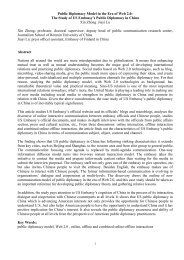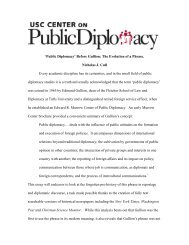Buddhist Diplomacy: History And Status Quo. - USC Center on ...
Buddhist Diplomacy: History And Status Quo. - USC Center on ...
Buddhist Diplomacy: History And Status Quo. - USC Center on ...
- No tags were found...
Create successful ePaper yourself
Turn your PDF publications into a flip-book with our unique Google optimized e-Paper software.
40 BUDDHIST DIPLOMACY: HISTORY AND STATUS QUOreligious intolerance by “coercively promoting Buddhism over otherreligi<strong>on</strong>s”. The report accused the Chinese government of restrictingTibetan Buddhism. 176 The United States also showed its c<strong>on</strong>cernover China’s pressure <strong>on</strong> Nepal to restrict Tibetan m<strong>on</strong>ks’ activitiesin the country. 1773. U.S. support of Myanmar <str<strong>on</strong>g>Buddhist</str<strong>on</strong>g> m<strong>on</strong>ks’ “Saffr<strong>on</strong> Revoluti<strong>on</strong>”(2007)In August 2009, Myanmar <str<strong>on</strong>g>Buddhist</str<strong>on</strong>g> m<strong>on</strong>ks took to street toprotest against the military junta’s mismanagement of the country.The protest movement became known as “the Saffr<strong>on</strong> Revoluti<strong>on</strong>”,named after the color of the <str<strong>on</strong>g>Buddhist</str<strong>on</strong>g> m<strong>on</strong>ks’ outer garments. Asthe military junta cracked down <strong>on</strong> the protests, the United Statesand the European Uni<strong>on</strong> issued a joint statement and called <strong>on</strong>the junta to stop the violence and open discussi<strong>on</strong>s with politicalpris<strong>on</strong>er Aung San Suu Kyi. The United States and the EU alsocalled <strong>on</strong> China, Ind<strong>on</strong>esia and India to use their influence toreduce tensi<strong>on</strong>s between the government and the people. In 2012,as Myanmar was experiencing significant political transformati<strong>on</strong>,the U.S. government urged the Myanmar government to release aprominent <str<strong>on</strong>g>Buddhist</str<strong>on</strong>g> m<strong>on</strong>k who was <strong>on</strong>e of the leaders of a 2007 antigovernmentuprising. 178<str<strong>on</strong>g>Buddhist</str<strong>on</strong>g> churches and lay <str<strong>on</strong>g>Buddhist</str<strong>on</strong>g> organizati<strong>on</strong>s within theUnited States have engaged in active internati<strong>on</strong>al exchangesacross the border. Buddhism was first brought to the United Statesby Chinese and Japanese immigrants in the 19th century and isstill practiced by many Asian immigrants. Since the 1950s, therehave emerged a number of distinct Americanized (or c<strong>on</strong>vert)<str<strong>on</strong>g>Buddhist</str<strong>on</strong>g> communities, namely Zen Buddhism inspired by JapaneseBuddhism, Tibetan Buddhism, the Theravada-inspired InsightMeditati<strong>on</strong> Movement, and Soka Gakkai Internati<strong>on</strong>al, an AmericanBranch of Soka Gakkai Japan. 179 Some of these communities, inparticular the Tibetan <str<strong>on</strong>g>Buddhist</str<strong>on</strong>g> community, have actively engagedin internati<strong>on</strong>al affairs. A study by the Pew Research <str<strong>on</strong>g>Center</str<strong>on</strong>g> showsthat as of 2010, there are about 1.7 milli<strong>on</strong> <str<strong>on</strong>g>Buddhist</str<strong>on</strong>g> immigrants











